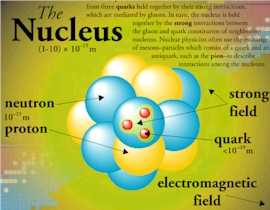BERKELEY -- After years of development and testing in high schools
across the United States and abroad, a spectacular new wall chart that graphically
illustrates fundamental principles, recent discoveries, and future directions in nuclear
science is hot off the press and available to teachers around the world.
 The central image of the nuclear
science wall chart
|
The central image of the four-color chart, a project that was spearheaded by scientists
at the Department of Energy's Lawrence Berkeley National Laboratory, illustrates the basic
structure of the nucleus -- protons, neutrons, and their quark constituents -- bound by
the strong interaction and surrounded by an electromagnetic field.
Separate sections of the chart are devoted to the expansion of the universe after the
Big Bang; phases of nuclear matter such as the nucleon gas and the quark-gluon plasma;
modes of radio-active decay; pathways to controlled nuclear energy; and applications of
nuclear science, from nuclear medicine to the humble smoke detector.
A chart of the nuclides shows atomic and neutron numbers for all known nuclei and
indicates their predominant decay modes and regions of greater nuclear binding energy
("magic numbers"). Brief discussions of unstable nuclei and the newly discovered
element 112 are included as well.
Members of Berkeley Lab’s Nuclear Science Division conceived the chart and
developed it with the Contemporary Physics Education Project (CPEP), an international
nonprofit organization of educators and physicists. Additional support came directly from
the Department of Energy and from Berkeley Lab’s Center for Science and Engineering
Education (CSEE), the National Science Foundation, the American Physical Society, and the
J. M. Nitschke Memorial Fund.
"Partly we were inspired by the great success of the Fundamental Particles and
Interactions chart that CPEP has distributed for years," says Howard Matis, Berkeley
Lab nuclear physicist and a leader of the project, "but perhaps more important was
our perception that most high school students lacked basic knowledge of physics. I
surveyed a number of schools and found that they all lacked materials to teach modern
physics."
Work began in 1995 with an amateur effort by Nuclear Science Division volunteers; they
presented a chart to CPEP that the educators thought was sound but stodgy.
"Everything it showed had been done 50 years ago," Matis says, "and later,
when we tried to add contemporary science, the result didn’t look coherent." At
this point, says Matis, "Rollie Otto, head of CSEE, volunteered to give us a
designer."
A new chart was laid out with the help of designer Christopher Slye that, Matis says,
emphasized "what’s happening now, including some mysteries. After all, anwering
unanswered questions is why we do science."
More meetings and more designs ensued. Designer Flavio Robles, Jr. joined the project
and did additional graphic work, while the chart's authors prepared a companion book,
"Nuclear Science, A Teacher's Guide." "It's very comprehensive," says
Matis of the guide. "I wish I knew everything in there."
In the spring of 1997, the prototype wall chart and guide were tested in some 250
schools in America, Australia, England, France, and other European countries. "The
chart was enthusiastically received everywhere," says Matis.
At last the work of a dozen core participants from Berkeley Lab and some three dozen
reviewers from the nuclear science community across the country, as well as CPEP, was
nearing fruition. "After we’d analyzed the questionnaires, corrected some
ambiguities, and made a few final changes, we finally went to press."
The finished chart comes in three sizes: a whopping 59 1/2 by 41 1/2 inches for
classrooms; 29 1/2 by 21 inches, perfect for the office wall; and 16 by 11 inches for
handy reference.
The chart and guide can be ordered from Science Kit, 777 East Park Drive, Tonawanda, NY
14150; telephone (800) 828-7777; fax (716) 874-9572; or over the web at http://www.sciencekit.com. To preview the chart on
the web, and to learn more about CPEP, see the CPEP website at http://pdg.lbl.gov/cpep.html.
The Berkeley Lab is a U.S. Department of Energy national laboratory located in
Berkeley, California. It conducts unclassified scientific research and is managed by the
University of California.